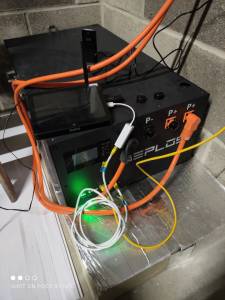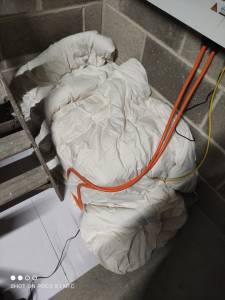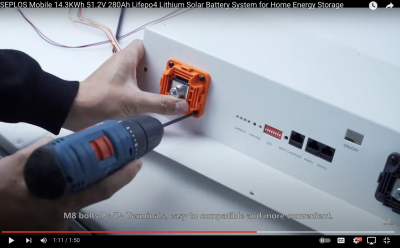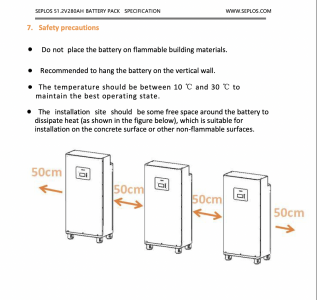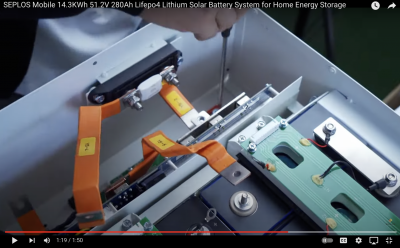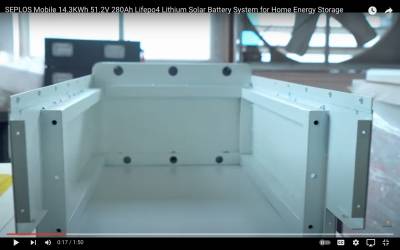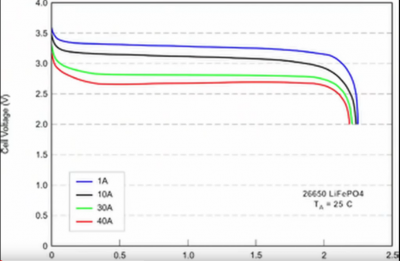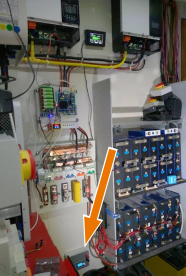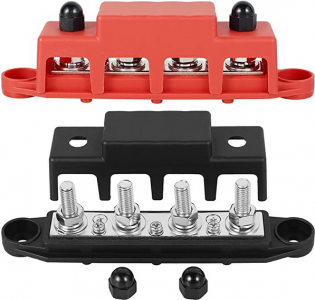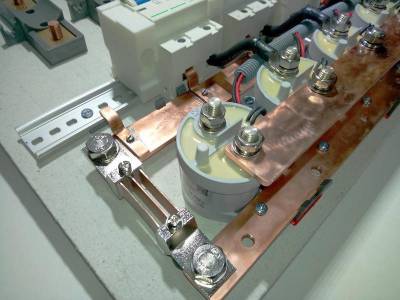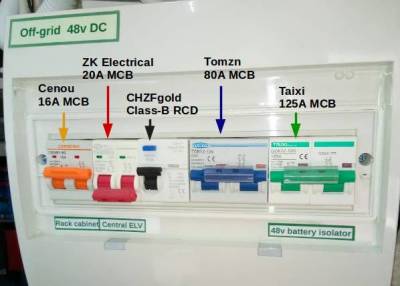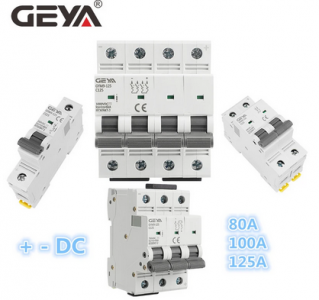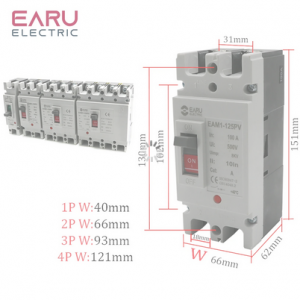Posted by: @transparent@korwraith - Could I perhaps suggest a method of insulating the front of the case which doesn't use a board covered with aluminium foil?
Also... when we say that the cells need 'balancing',
we're not expecting a 110Kg box to be left overhanging either side of wooden fulcrum! 🤣
Why a wooden fulcrum? Surely a steel fulcrum could achieve a sharper point which would necessitate more accurate balancing. 😋
@transparent the aluminium foil can peel off but I think it looks better left on; surely not any less safe than the Seplos steel casing 😅?
Don't worry, the Seplos box is very sturdy, zero flex across its length and easy manoeuvrability should I ever need access behind it 😁
Another here - I installed in Feb so also not a long time ago, but also ticking along fine. I had a week or so at looking at the settings, taking a look at cell voltages and pretty much left the BMS side alone since. I do however fiddle with the inverter settings to increase and decrease the overnight charging depending on whether there is going to be much solar the next day (using Solcast). I guess you wouldn't want to do this with your mother's system, a simple 75% charge in shoulder months and 50% in summer might do it?
You could perhaps put a cheap and cheerful PC connected to the BMS, which you could then remote log in to if you wanted to change and BMS settings - you can see in the picture below that I had mine connected to a small tablet based Windows PC (I'm mainly Mac and remembered I had this around to connect).
My battery is also connected in an unheated detached garage, I set it up on a spare bit of 100mm PIR I had, laid on the concrete floor. I had intended to build it in too, like other posters. However at the end of Feb when it was <0deg outside overnight and about 6deg during the day I put it an old duvet on it and tucked it in, the battery temps kept a nice 15deg or so for the week I had it like that, when the temps outside went back above zero I took it off.
Would be interested if you do end up getting the vertical Seplos and your opinion of it. One thing to note is it doesn't look like it's got multiple connectors so can't parallel with another battery (not that you may need 15kWh x 2 anyway!)
@vaugi Thanks for the data-point. Sounds like the system is pretty reliable once it has been set up. I'm not sure how much BMS configuration will be required when I'm not physically present; as a recovering site reliability engineer I take a risk-averse approach to simple changes since the recovery actions are potentially difficult. Moreover I'm not sure adding a Windows PC to the mix would increase reliability 🙂
I found a Seplos video on youtube which shows the vertical box has M8 bolts. This is fine as one can use bus-bars to give all the batteries equal length (and so resistance) connections. This might reduce the likelihood of issues that Off Grid Garage saw when connecting together two battery boxes.
Fogstar has the vertical box's manual which recommends 50cm ventilation space on either side of the box. I now feel a bit unsure about encasing the box in insulation ...
@chickenbig most of the planet is a fair bit warmer than the UK which I'd imagine is the operating conditions the manual writers had in mind when recommending heat dissipation spacing
That being said it'll be interesting to see how much the battery heats up during warm snaps in the summer
Posted by: @korwraithmost of the planet is a fair bit warmer than the UK
I believe the UK is catching up, at least in peak summer. I guess the insulation box around the battery/batteries could have a removable panel for summer. I imagine that aluminium tape for the edges could provide a good-enough hinge.
By the way, does the Seplos/Solis integration provide much useful battery info at the inverter monitoring level (do you have a wifi/ethernet stick and upload data to the cloud?), or would some additional monitoring prove useful? More components => more problems, so I hope the inverter monitoring is good enough.
@chickenbig Yes, the insulation panels are only held in place with double sided tape so can be easily removed should the temperature climb too high, although I think it unlikely.
I have the WiFi stick for my Solis inverter so I can view charge/discharge usage at high detail throughout the day, I can also see roughly how much charge is left in the battery and can view the reported battery voltage. I can't see individual cell voltages or temperature information.
I find the Solis app perfectly adequate for monitoring purposes and wouldn't think anything further would be necessary.
Posted by: @chickenbigthe vertical box has M8 bolts. This is fine as one can use bus-bars to give all the batteries equal length (and so resistance) connections.
I tend to agree.
I have been doing a lot of experimentation with busbars coupling batteries and inverters over the past year.
My approach also incorporates fuses, DC trips and 500A relays into the layout, for safety reasons.
There are still deficiencies in the layout I'm presently using.
For example, when a serious fault occurs, it will actually take down all inverters and all batteries... which isn't acceptable.
Please continue to discuss your approaches to combining batteries in Mason Boxes here.
I will chip in if I see you going down a route which I've already discovered to be 'sub-optimal'!
Save energy... recycle electrons!
Posted by: @korwraithI can also see roughly how much charge is left in the battery and can view the reported battery voltage. I can't see individual cell voltages or temperature information.
I find the Solis app perfectly adequate for monitoring purposes and wouldn't think anything further would be necessary.
Good to know, thanks!
Posted by: @transparentPlease continue to discuss your approaches to combining batteries in Mason Boxes here.
Seplos Mason boxes look to have a pre-charge resistor and also a 400A fuse of somewhat questionable breaking capacity (the vertical Mason video showed there was quite a lot of room around the fuse ... ).
Off grid garage Andy has also experimented with hooking up high and low state of charge batteries together, to check whether current limiting works; it does after a little delay so is probably good enough.
I think I favour taking a fairly noddy approach to connecting the two batteries; batteries connected directly to negative and positive bus bars (Victron 150A 4 pole bars fit the bill), and these bus bars connected to the inverter via fuses (NH00?) and (optionally) a two pole isolator although finding a cost effective two pole 56V isolator capable of handling > 100A is a challenge.
There are still some aspects of the Seplos Mason vertical which I am unsure of; are the cells compressed, how do the cells at the bottom react to the weight above it, plus the metal framework it sits in does not look to spread the pressure evenly across the faces. So this is still research phase work.
Posted by: @chickenbigAndy has also experimented with hooking up high and low state of charge batteries together, to check whether current limiting works; it does after a little delay so is probably good enough.
Current limiting in what part of the system?
In the BMS unit of the Mason box whose battery has the lower capacity?
My experimentation suggests that the best moment to connect two batteries in parallel is when they each have their capacity between 30-70% full.
Let me re-post a graph I've used elsewhere, which plots a cell's State of Charge (SoC) against voltage.
Mid-range, the voltage is pretty stable.
Using Ohms Law (V=IR) there will little current flowing between a pair of batteries if they are connected together within this range.
The more tricky point to consider is this:
Suppose I have two LiFePO4 batteries and one has a duff cell.
So I disconnect that battery.
I order a new cell, which arrives a couple of days later.
It gets installed in place of the faulty one.
Does my system layout provide me with a safe way by which I can re-connect those two batteries?
Should I have pre-charged that new cell to a particular capacity before installing it in the battery?
How can I assess that SoC?
Can I achieve this re-connection process if there is currently no 240v mains power from the grid?
Looking at the various scenarios which I might face, my own solution is to install a configurable CV/CC power-supply fed from the existing 'live' batteries.
It has 30A 4mm terminals, and can be set to charge up either a new cell, or the complete battery into which it is placed.
Save energy... recycle electrons!
Posted by: @transparentCurrent limiting in what part of the system?
In the BMS unit of the Mason box whose battery has the lower capacity?
So in this video Off Grid Garage conducts a test connecting 50% and 0% SoC batteries to check that the overcurrent alarm can limit charging to X Amps. The video demonstrates that the lower SoC battery can limit the current (presumably by rapidly switching off and on).
Posted by: @chickenbig.... batteries connected directly to negative and positive bus bars (Victron 150A 4 pole bars fit the bill), and these bus bars connected to the inverter via fuses (NH00?) and (optionally) a two pole isolator although finding a cost effective two pole 56V isolator capable of handling > 100A is a challenge.
I doubt those 'Victron' bus bars are different to scores of others available with current capacities up to 500A
Personally, I've decided to make my own from copper-bar, for which offcuts are available on ebay and elsewhere.
I can then drill and tap M8 or M10 holes and use copper, brass or stainless steel bolts or threaded bar, depending on what I want to connect.
A 25x4mm rectangular bar gives me 100mm² cross-sectional area, which is good for at least 500A.
High current DC isolators:
These are readily available on AliExpress (and hence ebay).
Double-pole DC Miniature Circuit Breakers (MCBs) between 80-125A are usually 3-modules wide (54mm) for clipping to a DIN-rail...
... except for those made by Geya, who manufacture DC double-pole MCBs up to 125A which are always 2-modules wide (36mm).
Above 125A, you'll need a Moulded Case Circuit Breaker (MCCB).
These no longer fit a DIN rail, but require screwing/bolting to a backboard.
MCCBs don't have 'standard' sizes, although most are similar.
Due to the absence of a suitable internal arc-suppressor, MCBs intended for use on AC circuits must not be used for isolating batteries and inverters.
Save energy... recycle electrons!
- 26 Forums
- 2,364 Topics
- 53.6 K Posts
- 116 Online
- 6,029 Members
Join Us!
Worth Watching
Latest Posts
-

@agentgeorge Alternatively …. Use cheapest tariff times...
By Toodles , 33 minutes ago
-

@majordennisbloodnok Education, Education, Education…
By Toodles , 2 hours ago
-

RE: Setback savings - fact or fiction?
Exactly. We only need to compare conditions, to decide ...
By cathodeRay , 5 hours ago
-
RE: Balancing financial efficiency and comfort using the Octopus Cosy tariff
I found because I have very low heat loss I can set bac...
By RadWhisperer , 8 hours ago
-
RE: Need Help Optimising My Rushed ECO4 Install: 12kW Bosch Heat Pump
Welcome @mickamills We too have an oversized 12kW Sa...
By Old_Scientist , 14 hours ago
-
RE: My Powerwall 3 Consumes 3-4 kWh/Day in Self-Consumption: Is This Normal?
@caron I can confirm that the power usage of the PW3 is...
By Old_Scientist , 15 hours ago
-
RE: Octopus Cosy Heat Pump Owners & Discussion Thread
@andrewj they will release smarter controls, its been m...
By swwils , 18 hours ago
-
RE: Speedcomfort radiator fans
Thats true, but having tried (and succeeded) in constru...
By JamesPa , 18 hours ago
-
RE: Solis S6-EH1P8K-L-PLUS – Why I Chose It and What I’ve Learned So Far
@bash brilliant, thanks for the feedback
By energy9165 , 20 hours ago
-

RE: Heat Pump Heats the House… But It’s Not Cosy. Emitter Changes or System Tweak?
@alastair There I was, feeling grumpy, he said “Cheer u...
By Toodles , 22 hours ago
-
RE: Grant Aerona: Is there a setting to keep the 2-port valve open during pump blockade
Depends on OAT. Mine cycles at OAT>10 and of course...
By JamesPa , 23 hours ago
-
RE: New Fogstar 15.5kWh upright solution
@transparent My conclusion is as you have noted, tha...
By Bash , 24 hours ago
-
RE: Mitsubishi Ecodan R290 10kW performance
And to you too. Wishing you a very enjoyable festive s...
By Sheriff Fatman , 1 day ago
-

RE: External pipework insulation
They do? But that isn't apparent from the photos we'r...
By Transparent , 1 day ago
-

RE: Say hello and introduce yourself
@velcro welcome to the forums. Please feel free start a...
By Mars , 2 days ago
-
Daikin EDLA11D3V3 DHW Settings
I have a newly installed EDLA11D3V3 which I'm still get...
By Velcro , 2 days ago
-
RE: Midea ASHP – how to set weather compensation
@curlykatie did you get sorted with this?
By MickaMills , 2 days ago
-
RE: MyVaillant Connect Regular Disconnect
Thanks. Yes, if the time is consistently 11pm every nig...
By buckwem , 3 days ago

